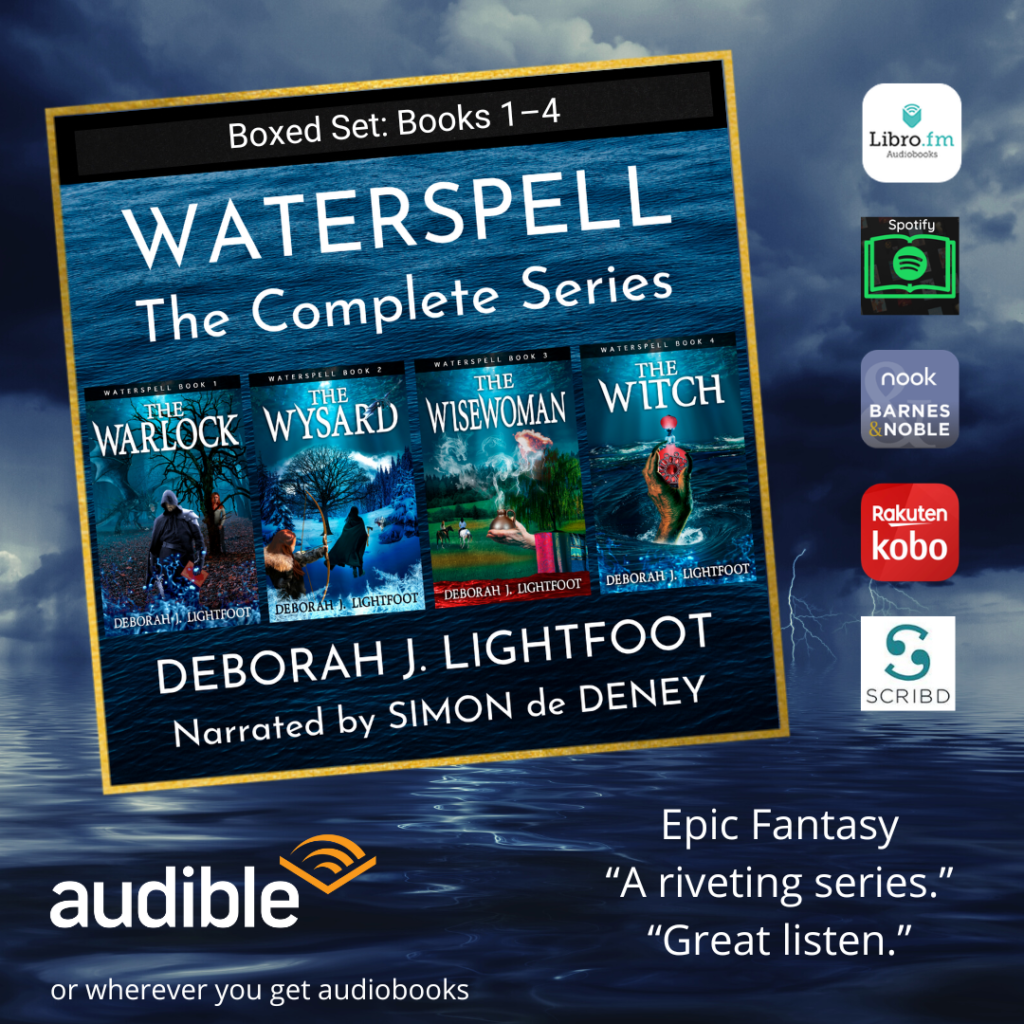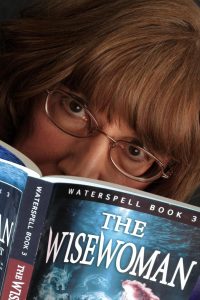I haven’t blogged in months because I’ve been traveling the world. The world of Waterspell, that is. The place keeps me busy. Here’s some of what’s happening:

The Karenina Chronicles
A Waterspell Novel
by
Deborah J. Lightfoot
Audiobook narrated by
Hannah Eggleton
Fall 2024
The Karenina Chronicles audiobook is nearly finished! Narrator Hannah Eggleton has done a beautiful job. Hannah has captured Nina’s voice, attitudes, and personality so perfectly that I must keep reminding myself that Hannah is Hannah, not Nina. 😁 We’re aiming for a Fall 2024 release. The audiobook will be available everywhere: Audible, Chirp, Hoopla, Barnes & Noble, Spotify, etc.
Here’s a 2-minute sample to whet your appetite. I love the strong self-confidence of Hannah’s voice.
The Sequel: Fires of Farsinchia
Yes, there’s a sequel in the works. The Karenina Chronicles is itself a stand-alone sequel to the original Waterspell quartet. To follow Nina’s story, you don’t need to have read the first four books. KC takes the saga into a new generation with new characters and conflicts.
But just as Nina demanded that I tell her full story in a chronicle of her very own, several characters from KC have also clamored for more time on the page. The result is turning into yet another Waterspell novel, to be called The Fires of Farsinchia. I’ve been handing out business cards with Fires listed alongside KC, which is putting the cart before the horse since Fires is still months away from publication. It won’t be listed yet by any bookseller.
To give googlers a search result, however, in case any recipient of my card googles the title, here’s the blurb, along with a sneak peek at the cover:
The Fires of Farsinchia
A Waterspell Novel
by
Deborah J. Lightfoot
With the revival of magic in the world of Ladrehdin, an ancient foe reawakens. Lady Karenina is called home to wield her wizardry against a power far older and deadlier. Will she survive? Who will hear her call for help?

You map lovers out there will be happy to know that Fires includes a map, this one drawn professionally by Tiffany Munro, cartographer for Feed the Multiverse Studio. This lovely and detailed map will be a great help to readers in following the new story through a complex landscape. I’m thrilled with it! 💙

Will There Be a Waterspell Book 7?
Possibly. I’m making notes for a book that could take the saga into the third generation. Two young adepts from The Fires of Farsinchia got married, and I’m sure their children will be unusually magically gifted. I may have to tag along on their further adventures, for I’m sure they’ll have many.
I need a break from this world, however. Since 2020, I’ve lived in the Waterspell universe. It has dominated my life. Which isn’t a bad thing at all, except I’m at the stage of life where I really should devote time to clearing out the clutter. My writing room is bursting with old projects, old notes, and files that need to be tossed. My late husband left a garage full of tools and bolts and fasteners of all kinds. It needs going through and boxing up for donation to Habitat for Humanity. Maybe I’ll take a year to declutter before tackling the story of the third generation in this fantasy family saga. Stay tuned!








 I snapped this picture at the
I snapped this picture at the  During a trip to England, I got to see the
During a trip to England, I got to see the  Four stone benches ring the well of the wysards in the cavern of enchantment deep beneath Verek’s manor house. The benches are arranged like the four cardinal points of a compass. When I came across this old vacation photo, I gasped in recognition. Look closely, and you can see the ornate E, S, and W directional markers of this stone compass that’s laid into the floor of a watchtower (or observation deck). The letter N for North barely appears at the left edge of the picture. I can’t remember exactly where I took this photo in the Texas Hill Country, but I’m inclined to think it’s either Longhorn Cavern or Inks Lake State Park in Burnet County, next to Inks Lake on the Colorado River. Seen through the lens of my writing, I easily picture the mirror pool replacing that stone mosaic in the center of the floor, with the benches set around the pool at the cardinal points, the directional letters giving way to carvings of key, crescent moon, fish, and radiant sun.
Four stone benches ring the well of the wysards in the cavern of enchantment deep beneath Verek’s manor house. The benches are arranged like the four cardinal points of a compass. When I came across this old vacation photo, I gasped in recognition. Look closely, and you can see the ornate E, S, and W directional markers of this stone compass that’s laid into the floor of a watchtower (or observation deck). The letter N for North barely appears at the left edge of the picture. I can’t remember exactly where I took this photo in the Texas Hill Country, but I’m inclined to think it’s either Longhorn Cavern or Inks Lake State Park in Burnet County, next to Inks Lake on the Colorado River. Seen through the lens of my writing, I easily picture the mirror pool replacing that stone mosaic in the center of the floor, with the benches set around the pool at the cardinal points, the directional letters giving way to carvings of key, crescent moon, fish, and radiant sun. For a year, I’ve been laying the groundwork:
For a year, I’ve been laying the groundwork:
 “Perfect for fans of Kristin Cashore and Charlotte Brontë.” From award-winning author Deborah J. Lightfoot, an unforgettable epic fantasy that readers call “extraordinary, enthralling, completely unpredictable.” Think “Jane Eyre meets a sorcerer.” Coming in 2022, Book 4 of Waterspell will complete the series. Print & ebooks available. Audiobooks in progress. www.waterspell.net
“Perfect for fans of Kristin Cashore and Charlotte Brontë.” From award-winning author Deborah J. Lightfoot, an unforgettable epic fantasy that readers call “extraordinary, enthralling, completely unpredictable.” Think “Jane Eyre meets a sorcerer.” Coming in 2022, Book 4 of Waterspell will complete the series. Print & ebooks available. Audiobooks in progress. www.waterspell.net









